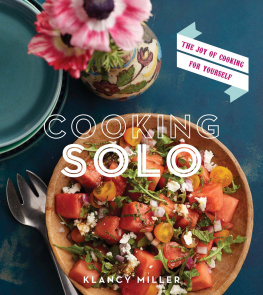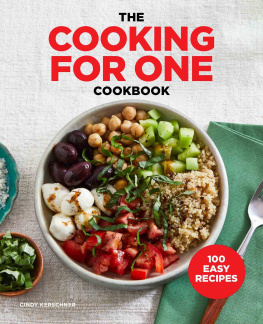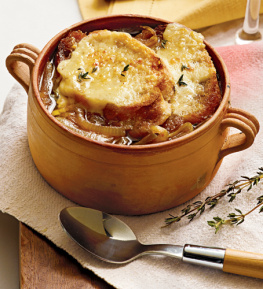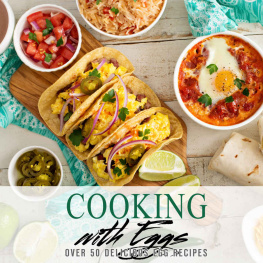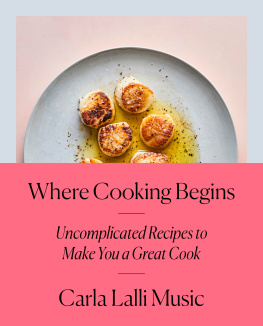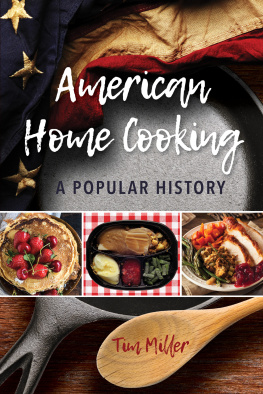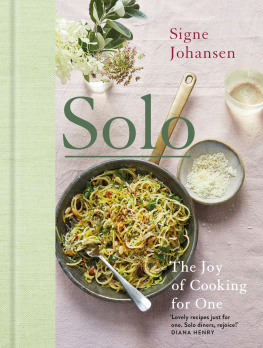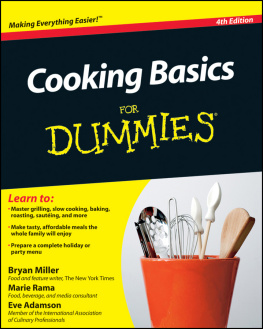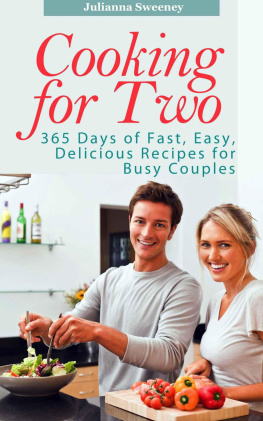CONTENTS

Preparing a meal for yourself is a special exercise, an unpressured act of creativity, self-care, and validation.
FROM THE INTRODUCTION
Its time to stop thinking of cooking for yourself as just another chore to check off the list. In Cooking Solo, Klancy Miller proves that making food for youand only youcan be a simple and fun way to give yourself a treat. After all, you wont have to worry about making anyone else happy (theres freedom to improvise and freedom to fail), and youll never have to compromise on what you feel like eating. (You want tacos three days in a row? Eat tacos three days in a row!) Cooking for one is about embracing your independence through good food.
Whether youre someone who avoids the kitchen at all costs or someone whos just learning the basics, the 100 totally-doable dishes in this book are the perfect ones to get you excited about what youll be making for your next meal. No technical skills are required here, and most recipes can be whipped up in 30 minutes or less!
Need something you can throw together in no time? Try the Scavenger Hunt Fried Rice with Kale, or the Guacamole Tartine. Feeling adventurous? The Ginger Biscuit-Scones with Quince Compote and the Smoked Duck Breast Salad are calling your name. Want to live a little luxuriously? Go for the Lobster Pasta Salad or Chocolate Pancakes with (Oh My Gosh) Ganache. With dishes from breakfast to dessert and everything in between (including some for entertaining with friends), youll have delicious recipes on hand to nurture and nourish yourself.

KLANCY MILLER is a writer and pastry chef deeply fascinated by all things French. After graduating from Columbia University and working in international development in French Polynesia, she earned a Diplme de Ptisserie at Le Cordon Bleu in Paris. Klancy stayed in Paris to apprentice in the pastry kitchen at the Michelin-starred Taillevent restaurant, and was later hired by Le Cordon Bleu Paris to join the recipe development team. During this time, Klancy was featured on Food Networks Recipe for Success in an episode about American culinary professionals in Paris. Now in New York, she continues to write about food. She was a commentator on the Cooking Channels show Unique Sweets and has been a contributor to the online magazine Food Republic . When shes not writing or cooking, Klancy takes hip-hop dance classes, throws waffle parties, obsesses about her next vacation, and searches for the perfect cookie.
Cover and author photographs Tara Donne
Cover design by Kara Plikaitis
I m a natural flneurthe French term for someone who loves to roam and explore on foot. When I moved back to New York from Paris, by way of Philly, strolling the city helped me discover the places that are now my favorite destinations for food (listed below).
If you live in a metropolitan area, you owe it to yourself to explore the local food resources. If you dont, be assured that even small-town supermarkets stock sea salt, extra-virgin olive oil, and other once hard-to-find ingredientsand that with an Internet connection and a little lead time, you can source virtually any ingredient you need. (One of my favorite online resources is lepicerie.com.)
Heres a list of basic ingredients I keep on hand, most of which are used in the recipes ahead. Consider it a starting point, and expand it based on your personal tastes and explorations. Remember that, especially for solo cooks, small quantities are best. No matter how carefully you store them, most food items will eventually lose quality, so dont buy too much at a time.
THEY INCLUDE:
For seafood:
Lobster Place in Chelsea Market
75 Ninth Ave., New York, NY 10011
lobsterplace.com
For Japanese ingredients:
Sunrise Mart
4 Stuyvesant St., New York, NY 10003
For fresh pasta:
Eataly
200 Fifth Ave., New York, NY 10010
eataly.com
For Sicilian sundried tomatoes:
Buon Italia
75 Ninth Ave., New York, NY 10011
buonitalia.com
For hard-to-find spices:
SOS Chefs
104 Ave. B, New York, NY 10009
sos-chefs.com
For the best baguettes in Manhattan:
Maison Kayser
1294 Third Ave., New York, NY 10021
For superb ginger molasses cookies:
BKLYN Larder
228 Flatbush Ave., Brooklyn, NY 11217
bklynlarder.com
STAPLES
Salt
Salt is so essential to cooking and baking that it belongs at the top of any shopping list. By bringing out the nuances in other flavors, it makes both sweet and savory dishes shine. There are two categories of salt: the type that is mined, which includes table salt, kosher salt, and rock salt, and the kind that is produced by evaporating seawater. Many table salts undergo iodization, the addition of the micronutrient iodine, which is necessary for normal thyroid functioning and brain development. All but two of the recipes in this book can be made successfully with table salt. (The exceptions are Mood-Boosting Rib Eye, , which is best with flaky sea salt.) These are the kinds of salt I like best:
FINE SEA SALT: With its small crystals, its what I reach for when a recipe calls for salt, and I encourage you to use it in my dishes. My favorite is the French brand La Baleine, which is available at Whole Foods Market and many supermarket chains and online retailers.
FLEUR DE SEL: Literally flower of salt, its made by skimming the crystals that float to the tops of salt ponds. I use this flaky sea salt in baked goods and sometimes as a finishing touch for chocolate or caramel. Its not cheap, but because you need to use so little at a time, a container lasts quite a while.
KOSHER SALT: I like using large-grain kosher salt for grilling meats and preparing marinades. Because the salt crystals are bigger, they are easier to handle. For the same reason, kosher salt is not appropriate for baking.
PINK HIMALAYAN SALT: Mined in Pakistan, this coarse salt gets its slightly pink hue from iron oxide. I use it regularly, often in place of table salt for savory and sweet recipes.
A note about measuring salt: The smallest quantity in most measuring-spoon sets is teaspoon, and that is too much salt for a solo serving. Thats why I often instruct you to use a pinch or two of salt and I encourage you to constantly taste and adjust the seasoning as you cook.
Oils
Oils are perishable, so its important to purchase small quantities and store them away from light and heat in the cupboard. Oils that you use only occasionally are best refrigerated. (Take them out before you start cooking to allow them time to come to room temperature and reliquefy.) If, despite your best efforts, you detect a bitter, rancid aroma, toss the oil out; using it will ruin your dish. Here are the types of oil I keep on hand:
EXTRA-VIRGIN COCONUT OIL: Enjoying nutritional buzz as a healthy saturated fat with cholesterol-improving properties, coconut oil is white and hard when cold, but liquefies and becomes clear when warmed. I love its mildly sweet, nutty flavor in treats such as Chocolate Pancakes with (Oh My Gosh) Ganache (). It also adds a certain je ne sais quoi, as the French say, to sauted vegetables. There are many brands available; be sure to choose one labeled extra-virgin.
EXTRA-VIRGIN OLIVE OIL: Used in nearly every recipe in this cookbook, this indispensable oil is produced in the first pressing of tree-ripened olives. Treated with neither chemicals nor heat, as are lesser grades of olive oil, it has low acidity (less than 1 percent) and a fruity taste. I prefer extra-virgin olive oil from Italy or Greece, and I use it for everything from sauts to vinaigrettes and in baked goods. When I run out of butter, Ive even been known to use it in pancake recipes.

